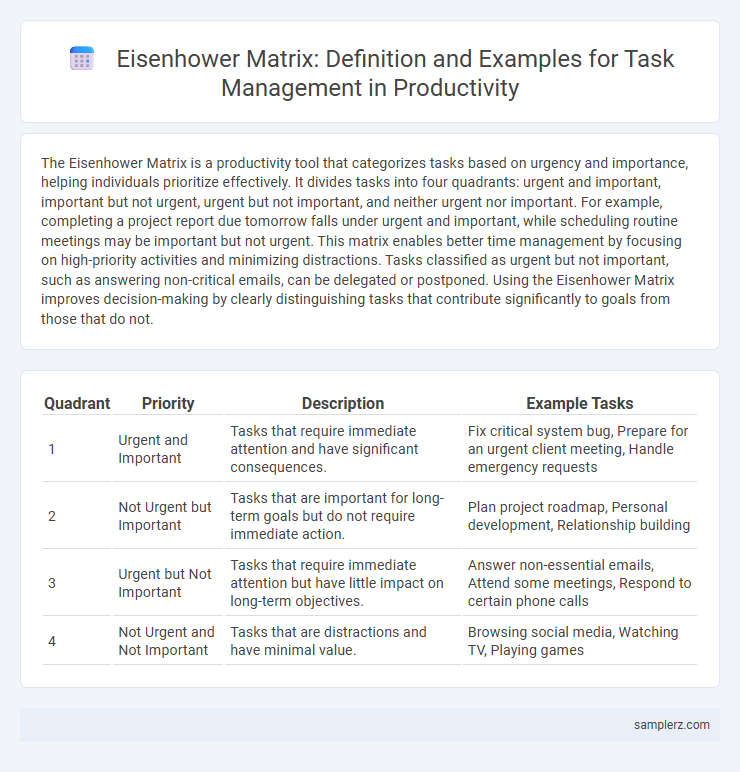The Eisenhower Matrix is a productivity tool that categorizes tasks based on urgency and importance, helping individuals prioritize effectively. It divides tasks into four quadrants: urgent and important, important but not urgent, urgent but not important, and neither urgent nor important. For example, completing a project report due tomorrow falls under urgent and important, while scheduling routine meetings may be important but not urgent. This matrix enables better time management by focusing on high-priority activities and minimizing distractions. Tasks classified as urgent but not important, such as answering non-critical emails, can be delegated or postponed. Using the Eisenhower Matrix improves decision-making by clearly distinguishing tasks that contribute significantly to goals from those that do not.
Table of Comparison
| Quadrant | Priority | Description | Example Tasks |
|---|---|---|---|
| 1 | Urgent and Important | Tasks that require immediate attention and have significant consequences. | Fix critical system bug, Prepare for an urgent client meeting, Handle emergency requests |
| 2 | Not Urgent but Important | Tasks that are important for long-term goals but do not require immediate action. | Plan project roadmap, Personal development, Relationship building |
| 3 | Urgent but Not Important | Tasks that require immediate attention but have little impact on long-term objectives. | Answer non-essential emails, Attend some meetings, Respond to certain phone calls |
| 4 | Not Urgent and Not Important | Tasks that are distractions and have minimal value. | Browsing social media, Watching TV, Playing games |
Understanding the Eisenhower Matrix: A Brief Overview
The Eisenhower Matrix categorizes tasks into four quadrants based on urgency and importance, helping prioritize effectively. Tasks are divided into urgent and important, important but not urgent, urgent but not important, and neither urgent nor important, streamlining decision-making. This method enhances productivity by focusing on high-impact activities and reducing time spent on distractions.
Categorizing Tasks: The Four Quadrants Explained
The Eisenhower matrix divides tasks into four quadrants based on urgency and importance: Quadrant 1 includes urgent and important tasks like critical deadlines; Quadrant 2 involves important but not urgent activities such as strategic planning; Quadrant 3 covers urgent but less important interruptions like some emails; Quadrant 4 contains neither urgent nor important distractions like excessive social media. This categorization enhances productivity by prioritizing high-impact tasks and minimizing time spent on low-value activities. Adopting the Eisenhower matrix fosters focused work and better time management.
Quadrant I Example: Urgent and Important Tasks
Quadrant I in the Eisenhower Matrix includes urgent and important tasks such as meeting immediate project deadlines, handling critical client issues, or addressing sudden operational crises. These tasks demand prompt attention to prevent negative consequences and ensure workflow continuity. Prioritizing Quadrant I activities effectively reduces stress and enhances overall productivity.
Quadrant II Example: Important but Not Urgent Tasks
Focusing on Quadrant II of the Eisenhower Matrix emphasizes tasks that are important but not urgent, such as strategic planning, skill development, and relationship building. Prioritizing these activities enhances long-term productivity by preventing crises and reducing urgent interruptions. Regularly dedicating time to Quadrant II ensures sustained growth and efficient time management.
Quadrant III Example: Urgent but Not Important Tasks
Quadrant III of the Eisenhower Matrix includes tasks such as responding to non-essential emails, attending unnecessary meetings, and handling interruptions that demand immediate attention but do not significantly contribute to long-term goals. These urgent but not important tasks often distract from high-priority work and should be delegated or minimized to enhance overall productivity. Recognizing and managing Quadrant III activities helps individuals maintain focus on meaningful projects that drive success.
Quadrant IV Example: Neither Urgent nor Important Tasks
Tasks in Quadrant IV of the Eisenhower Matrix include excessive social media browsing, watching non-educational videos, and aimless internet surfing. These activities neither contribute to productivity nor require immediate attention, often leading to time wastage. Identifying and minimizing such distractions can significantly enhance overall efficiency and focus.
Daily Task List Breakdown Using the Eisenhower Matrix
The Daily Task List Breakdown using the Eisenhower Matrix categorizes tasks into four quadrants: urgent and important, important but not urgent, urgent but not important, and neither urgent nor important. Prioritizing tasks in the urgent and important quadrant, such as project deadlines or critical meetings, enhances productivity by focusing on immediate results. Tasks in the important but not urgent category, like strategic planning or skill development, support long-term goals and reduce future stress.
Practical Examples for Each Eisenhower Matrix Quadrant
The Eisenhower Matrix categorizes tasks into four quadrants: urgent and important, such as meeting critical project deadlines; important but not urgent, like strategic planning or skill development; urgent but not important, including routine emails or minor requests; and neither urgent nor important, such as excessive social media browsing or unnecessary meetings. Focusing on quadrant one ensures immediate priorities are addressed effectively, while quadrant two tasks drive long-term success by fostering growth and prevention. Limiting time spent in quadrants three and four maximizes productivity by reducing distractions and non-essential activities.
Tips for Implementing the Eisenhower Matrix in Your Workflow
Categorize tasks by urgency and importance to effectively implement the Eisenhower Matrix in your workflow, focusing first on critical and time-sensitive activities. Use digital tools like Trello or Todoist to visually separate tasks into four quadrants, enhancing clarity and prioritization. Regularly review and adjust task classifications to maintain productivity and prevent urgent but less important tasks from dominating your schedule.
Real-World Case Study: Increasing Productivity with the Eisenhower Matrix
A marketing manager at a mid-sized tech company applied the Eisenhower Matrix to prioritize daily tasks by categorizing urgent campaign deadlines and important strategic planning separately, leading to a 30% increase in project completion rate within three months. By focusing on Quadrant II activities, which emphasize important but not urgent tasks, the manager reduced time spent on distractions and improved long-term productivity. This real-world case study demonstrates how effective task prioritization boosts overall team efficiency and goal achievement.

example of Eisenhower matrix in task Infographic
 samplerz.com
samplerz.com